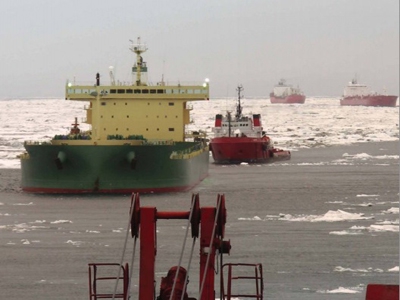Technical and regulatory information for shipowners to promote safe shipping in Arctic waters
Image Credit: Photo of the cover of ABS Advisory on Navigating the Northern Sea Route (Rosatomflot)
ABS has released its Navigating the Northern Sea Route Advisory to support shipowners and operators intending to transit the increasingly popular commercial shipping routes through the Arctic seas.
The comprehensive advisory, which was developed with assistance from Russia’s Central Marine Research and Design Institute, provides owners with the information they need to apply for permits and to identify the possible technical and operational risks that could arise when trading in some of the world’s most challenging commercial shipping environments.
“The Northern Sear Route was virtually unnavigable by all but powerful icebreakers just a few short years ago,” says Todd Grove, Chief Technology Officer for ABS, noting that the Russian Federation’s recent moves to encourage international shipping through the Northern Sea Route (NSR) and the melting ice floes there have opened commercial shipping opportunities.
“The NSR’s growing popularity has positive implications for transit times between Asia and Northern Europe,” Grove explains, “but the often unpredictable and unfamiliar shipping environment through the north also poses operational and technical challenges. This Advisory was developed to provide the industry with some of the information it needs to navigate those challenges safely and efficiently, while also helping to minimize the impact on the environment.”
|
The Advisory includes the following:
|

The fastest navigation routes for ships seeking to cross the Atlantic Ocean during September currently favor the Northern Sea Route along Russia’s coastline. (Proceedings of the National Academy of Sciences) / Image Credit: ABS Advisory
Trading through the NSR has the potential to reduce the typical transit times between Japan and Rotterdam by as much as 3,400 miles – or 10 days – compared to the traditional route via the Suez Canal. This reduction brings with it commensurate gains in overall vessel utilization and reductions in bunker costs.
The NSR also will provide access to the growing energy and industrial activity in northern Russia, projects that already have led to greater tanker traffic in the area and provided the impetus for several recent orders of ice-class LNG carriers for future export trades.
|
The NSR is described as running through the Kara, Laptev, Vostochno-Sibirskoye (East Siberian) and Chukchi Seas. The NSR can be entered from the west through the Yugorskiy Shar Strait or the Karskiye Vorota Strait, or by passing north of the Novaya Zemlya Islands around Mys Zhelaniya; and from the east through the Bering Strait. Open water depths for the NSR vary from between 20 to 200 m. Different route options require transiting one or more of the many straits along the route. The NSR can be divided into three principal climatic areas.
|
While the Advisory captures the latest regulatory information available at the time of publication and an overview of typical shipping conditions, it is intended strictly for informational purposes.
For more details, please read the ABS Advisory – Navigating the Northern Sea Route (click at image below)
Additional Information
Northern Sea Route Administration website www.NSRA.ru
ABS Guide for Vessels Operating in Low Temperature Environments
































































